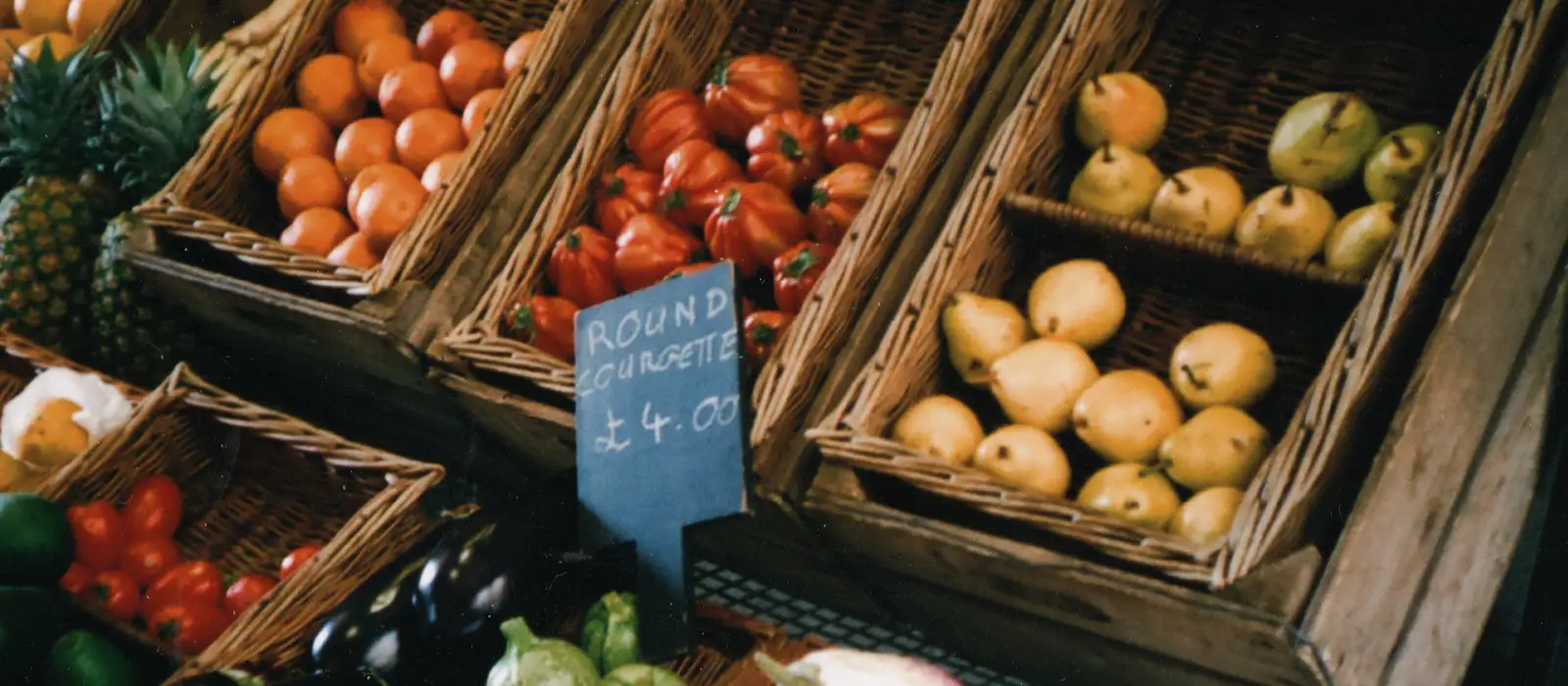How often do you walk into a Supermarket to pick up a few staples, only to leave 50 dollars poorer, feeling guilty for impulse buying those treats, and overstocked on items you didn’t really need?
You’re not alone… Supermarkets are masters of food marketing! Everything in your supermarket – from its floor plan to the color of signage- is engineered to keep you in store, and spending more.
And all too often, these clever tactics are geared towards making us buy food that is not so nutritious. So ultimately, our wallet and health suffers as a result!
One of the easiest ways to beat supermarkets at their own game is to shop more often at farmer’s markets, local stores and even better, grow your own food!
But, not all of us have access to the above. So sometimes we need to visit the supermarket. The next time you do, save yourself some money and stick to your health goals by knowing the top 7 traps, and our supermarket savvy tips to avoid them!
TRAP 1: The Format Formula
Food retailers know that most people need key staples in their regular grocery trip. Therefore, they cleverly place essential items along the perimeter of the store, so that you are forced into a lap of the entire supermarket. This forces you to bypass items that you don’t necessarily need but are impulsively compelled to pick up.
TRAP 2: Specials That Aren’t Quite So Special
Most people are hooked by signage reading ‘special’ or ‘sale’. After all, our money is hard-earned and we all love a bargain, right?
However, your actual savings may not be as wonderful as the flashy signs would lead you to believe. When you read the fine print, you may be saving a mere few cents on that purchase. Is this really a saving if it’s not an item you didn’t really need in the first place?
TRAP 3: Labelling Lies
Health claims aren’t always what they first seem. For example, products that read ‘light’ may not be actually light in fat or salt – food manufacturers can justify this claim by saying that the product is ‘light’ in color.
Whilst not every health claim you read is going to be false, don’t base your purchasing decisions purely on these statements. Take the time to study ingredients lists and use your own discernment. At the bottom line, many food manufacturers are more interested in your money than your health.
TRAP 4: Product Placement
Food companies spend big bucks on ensuring that their products are displayed at deluxe viewing locations. This is usually around eye level height. However, just because a product catches your eye first doesn’t mean it’s the healthiest or cheapest option on the shelves.
Pump out a few supermarket squats and take the time to look high and low to compare products. Many smaller health food companies won’t have the budget to spend on prime shelf real estate. But with a little special effort on your part, you can still find these hidden gems.
TRAP 5: FoMO
Supermarkets tap into our FoMO (Fear Of Missing Out) with ‘limited time’ specials and offers that cap the quantity of items that we can buy. If you’re a price sensitive shopper, you may be more likely to be tempted to dip into a special to get your share… Only whilst stocks last!
TRAP 6: Impulse Buys
Let’s face it, grocery stores don’t display that gleaming, glittering row of confectionery at the check-out because they want you to be healthier. Retailers know that once you’ve done the bulk of your shopping, an extra goodie doesn’t seem like a big expense and you’re usually hungry and tired enough to be enticed into this offer.
TRAP 7: Suggestive Coupling
What goes with best with pasta? Well, the answer to that is usually sitting beside it on the shelf. Unless your answer was wine! 😉
Grocery stores cleverly pair items so that you are inspired to opt in and buy the extra ‘must-have’ that goes with it. At this point of purchase, it all seems convenient and logical. But how often are we buying something that we actually need in the cupboard at home?
Here are some tips to become a savvy shopper:
SAVVY SHOPPER TIP 1: Perfect Your Plan
Shopping without a plan is virtually a recipe to break the budget and make hasty purchasing decisions. Alternatively, spend ten minutes before you shop to write a rough list of healthy meals that you would like to make that week. Then, simply jot down a brief list of the foods you need to make those meals.
Flesh out your list with extra items to supply breakfasts and snacks, plus other toiletries you need around the home. Lastly, give yourself three blank spaces to fill with spontaneous purchases once you start shopping. This will help you to feel less restricted but still counteract our natural human tendency to buy more than we intend to.
SAVVY SHOPPER TIP 2: Spare A Care For Your Cupboard
How often do you unpack your celery to find a wilted bunch already sitting sadly in the fridge? Our lives are busy and it’s virtually impossible to track exactly what we use in the kitchen as the week progresses.
Before you shop, sweep a brief glance through your cupboards and fridge. You don’t need to obsessively record everything you already have but this rough mental inventory will still help to prevent some double-ups.
SAVVY SHOPPER TIP 3: Be Your Own Banker
Maybe you’re already great at writing shopping lists but struggle to follow through on the most important step… sticking to them!
If this sounds familiar, trial ‘being your own banker’ next time you shop. In advance, withdraw your grocery budget allowance in cash. Then, only take this amount into the grocery with you. Deprived of any other way to buy extra, your budget is bulletproof.
SAVVY SHOPPER TIP 4: If Possible, Leave The Little Ones At Home
Whilst we love them most dearly, shopping with children can be a little more stressful. We are more distracted and tend to rush in and out before any tantrums can erupt! Additionally, children commonly put extra pressure on parents to buy foods that wouldn’t be your first choice for their precious, growing bodies.
Although it may not always be possible, if you are able to shop without needing to supervise children, you will have more time and mental energy to think through your buying decisions. Alternatively, you could also trial shopping online in a peaceful space at home.
SAVVY SHOPPER TIP 5: CARRY YOUR CALCULATOR
Remember how we discussed that specials may not really offer the savings that the signs suggest? If the true saving isn’t displayed in the fine print, the best way to find out is to calculate the unit price yourself. And unless you’re a maths whizz, a calculator will go a long way to help!
A calculate can also help you compare unit value between comparable products that aren’t on special. Simply divide the cost of a product by the number of units (eg oz) that it contains. You will end up with a price per unit for each product that can determine what is truly cheaper!
SAVVY SHOPPER TIP 6: Downsize Your Cart
Ever noticed how supermarket trolleys seem to be getting bigger? This tactic is designed to deceive us into how much we are really piling in there.
Simply opt for the smaller available carts. You can also place other items (such as your sustainable non-plastic bags or handbag) in the bottom of the large trolleys to fill in the extra space.
SAVVY SHOPPER TIP 7: Avoid The Hungry Man’s Dilemma
Think back to the last time you felt hungry…. Chances are that your sense of smell was more acute, your thinking was hazier and unhealthy foods seemed somehow a little more virtuous.
Shopping on an empty stomach will encourage you to choose less healthy foods and hasten through your purchases… So you can get home and eat! If you haven’t had time to eat before shopping, try buying (and eating) a healthy snack before you go back in store for your full shop.
Thanks for reading savvy shoppers! What’s your hot tip for staying true to your health and budget in the supermarket?
How To Clean Your Home With Essential Oils
Did you know that the average American home is filled with thousands of artificial chemicals? Only a small percentage of these chemicals have been thoroughly tested for safety! It’s crazy considering how often we’re exposed to these chemicals, and how little we know about their effects on our health and the environment.
Of those that have been studied, at least 150 common household chemicals have been associated with cancer, psychological disturbances, allergies, gastrointestinal disorders and various health issues. Shocking right?!
Cleaning agents contribute a substantial amount to the toxic chemical load in our home. Many top brand cleaners are filled with known toxins such as solvents, ammonia, formaldehyde, phthalates and ethanolamine.
With so many viable natural cleaning solutions now available, how could the potential (and known) risks of these toxins ever be worth a bleached-clean home?
Many essential oils mimic the results of chemical cleaners. They can dissolve grease, brighten stains, kill mold spores and fight bacteria… But without all the scary health dangers!
Check out these eco-friendly cleaning solutions that are natural, non-toxic, simple and actually work!
But please note, when working with essential oils on a new surface, always patch test first to check for suitability. Even though they come from Mother Nature, these oils are potent!
CLEANING PURPOSE: Mold & Mildew
Recommended Essential Oils:
- Clove (removes mold & mold spores)
- Cinnamon
- Pine (also kills yeast spores)
- Tea tree
Suggested uses:
- Mix 2 teaspoons of tea tree oil with 2 cups of warm water. Spray and leave on shower surfaces to detract mold.
- Mix 1 teaspoon of clove oil with 1 cup of vinegar and 1 tablespoon glycerine. Spray over moldy areas and leave for 15 minutes before wiping away with a damp cloth.
CLEANING PURPOSE: Disinfectant
Recommended Essential Oils:
- Tea Tree
- Eucalyptus
- Thyme oil
Suggested Uses:
Combine 2 cups hot water, ¼ cup washing soda and 10 drops of your choice of the above essential oils. Spray as needed and wipe away with a microfibre cloth.
CLEANING PURPOSE: Degreaser
Recommended Essential Oils:
- Lemon
- Orange
Suggested Uses:
Combine ½ cup water, ½ cup vinegar, 1 tbsp castile and 10 drops of either above oils. Soak a sponge in this mixture and use light pressure to lift grease. Wipe away soapy residue with a warm damp cloth.
CLEANING PURPOSE: Floor Wash (not suitable for timber flooring)
Recommended Essential Oils:
- Tea Tree
- Eucalyptus
- Lemon (brightens and removes stains, eg white tiles)
- Pine
Suggested Uses:
Use a 1:1 mixture of vinegar and hot water and add 15 drops of any above oils. Mop and enjoy the bright, streak-free and fresh finish!
CLEANING PURPOSE: Combs and Makeup Brushes
Recommended Essential Oils
- Tea tree
- Lavender
- Eucalyptus
Suggested Uses:
Combine ½ cup warm water, 1 tablespoon vinegar and 5 drops of any above oils in a jar. Soak brushes for 15 minutes then rinse thoroughly. Leave in the sun to dry out thoroughly.
CLEANING PURPOSE: Shower Scum & Grime Build Up
Recommended Essential Oils:
- Lemon
- Tea tree
Suggested Uses:
- Wipe or spray your shower surfaces with a little water containing several drops of lemon oil. Done once or twice a month, this will help to prevent grime build up!
- Buy an empty spray bottle and fill with vinegar and a couple of spoon of tea tree oil. Use as a daily antibacterial cleaning spray for your shower and bath.
CLEANING PURPOSE: Windows
Recommended Essential Oils
- Lavender
- Lemongrass
Suggested Uses:
Combine 1:1 hot water and vinegar and add 10 drops of either oils listed above. Wipe over windows and use a ‘squeegee’ to remove the liquid. Use old newspaper to polish glass to a streak-free shine afterwards!
CLEANING PURPOSE: Antibacterial Solution
Recommended Essential Oils:
- Lemon (also antiviral)
- Tea tree (also antiviral, antifungal and antimicrobial)
- Rosemary (also antiseptic)
- Lavender
- Cinnamon (also antibacterial)
Suggested Uses:
Soak dirty Tupperware in vinegar and a few drops of the above oils before rinsing through a hot cycle of the dishwasher.
CLEANING PURPOSE: Linen & Bedding
Recommended Essential Oils:
- Lavender
- Eucalyptus (also fights dust mites)
Suggested uses:
- Add a few drops of eucalyptus or lavender oil when washing quilts, mattress covers and pillows.
- Add a few drops of lavender oil to your linen spray for a beautiful, natural fresh scent on your clothing.
CLEANING PURPOSE: Stove & Cooktops
Recommended Essential Oils:
- Orange
Suggested Uses:
Mix 10 drops of orange oil with ¼ cup castile soap to wipe down stove tops and counters. Wash clean with a little warm water.
CLEANING PURPOSE: Dishwash Liquid
Recommended Essential Oils:
- Lime
- Orange
- Rosemary
Suggested Uses:
- Combine 1 cup of liquid castile soap, 10 drops lime oil, 10 drops orange oil. (Optional: Add a few drops of glycerine to emulsify the oils into the mixture, otherwise simply shake before use.)
- Got some REALLY greasy pots and pans to take care of? Try adding ½ cup vinegar and lemon juice to the above mixture.
CLEANING PURPOSE: Toxin-free Kitchen Wipes
Recommended Essential Oils:
- Lavender
- Eucalyptus
- Orange
- Lime
- Tea Tree
- Peppermint
Suggested Use:
Ditch the paper towel and toxic antibacterial wipes! Simply cut up some old white colored rags into hand-sized squares. Fill a large jar with 1 cup of water, 1 ounce castile soap, 1 ounce vinegar and 10 drops of any of the above oils. Soak the cloth squares inside and remove as needed to wipe away spills or wipe down bench tops. Simply wash and reuse the square cloths time and time again!
CLEANING PURPOSE: Sink Scrubber
Recommended Essential Oils:
- Rosemary
- Eucalyptus
- Tea Tree
- Lemon (particularly if greasy)
- Orange (particularly if greasy)
Suggested Uses:
- Combine ¼ cup of washing soda, ¼ cup baking soda and 10 drops of any of the above essential oils. Smear over sink surface and leave for 15 minutes before rinsing away with 1 cup vinegar and hot water.
- Combine 1 cup baking soda, ½ cup pure castile soap and 5 drops of the above oils in a small bowl. Mix well and scoop the mixture onto a sponge to give your sink a good scrub over. Wash well with warm water.
CLEANING PURPOSE: Toilet Gel
Recommended Essential Oils:
- Tea Tree
- Eucalyptus
- Peppermint
Suggested Uses:
- Make your own bottle of non-toxic toilet cleaner by combining 2 cups water, ¼ cup castile soap, 1 tablespoon tea tree oil and 10 drops of eucalyptus or peppermint oil. Spread mixture over surface of inner toilet bowl and soak for 20 minutes. Lightly scrub with a toilet brush before flushing away the muck and leaving sparkly clean results!
- Pour 1 cup baking soda and a few drops of the above essential oils into the toilet. Pour over 2 cups of vinegar. After the fizzing settles down, scrub the toilet bowl over with a toilet brush and flush several times.
Ready to make your own DIY home cleaners? Stock up on the essential oils listed above, PLUS these simple ingredients:
- Bicarb soda
- Salt (scrub)
- Vinegar
- Washing soda (also called sodium bicarbonate or soda ash)
- Liquid castille soap
- Glycerine (emulsifier)
Add a little of the relevant essential oil to any of the above for a quick, easy, effective and natural DIY cleaning kit!
The potential uses for essential oils in natural cleaning is only limited by our imagination. What’s your favorite way to clean with essential oils?



